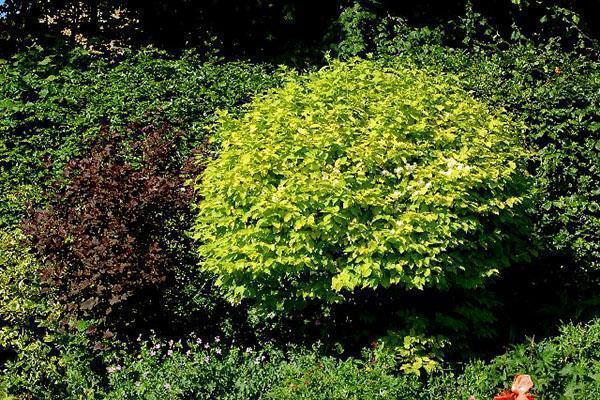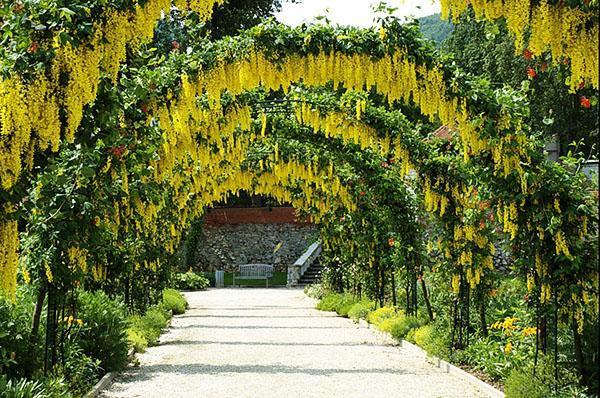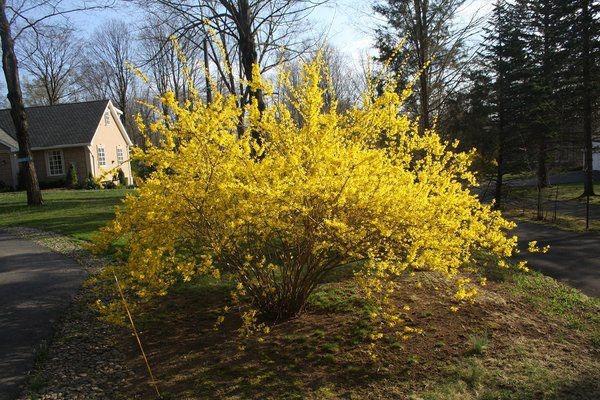Make your yard sunny by planting yellow plants in your garden
 We are all accustomed to the fact that summer abounds in greenery, and autumn, entering its own rights, paints the leaves yellow. During this period, the garden is transformed and begins to play with golden colors, which is perceived by people as a natural state of affairs. When yellow leaves appear in the summer, many immediately sound the alarm and try to cure the "sick" plants.
We are all accustomed to the fact that summer abounds in greenery, and autumn, entering its own rights, paints the leaves yellow. During this period, the garden is transformed and begins to play with golden colors, which is perceived by people as a natural state of affairs. When yellow leaves appear in the summer, many immediately sound the alarm and try to cure the "sick" plants.

 Even in bad weather, your site will be beautiful and remind you of the sun's rays, which will soon replace bad weather. The barberry “Thunberg Aurea” and the crown mock-orange “Aurea” will shine with bright yellow spots in the raindrops. That's very beautiful.
Even in bad weather, your site will be beautiful and remind you of the sun's rays, which will soon replace bad weather. The barberry “Thunberg Aurea” and the crown mock-orange “Aurea” will shine with bright yellow spots in the raindrops. That's very beautiful.
 If you have a western thuja hedge, then it can be evenly diluted with Semperaurea or Reingold thuja, then the whole composition will become a pleasant yellow-green color due to the golden needles of these varieties. Breeds with yellow leaves are also suitable, such as the Canadian elderberry "Aurea" or golden alder.
If you have a western thuja hedge, then it can be evenly diluted with Semperaurea or Reingold thuja, then the whole composition will become a pleasant yellow-green color due to the golden needles of these varieties. Breeds with yellow leaves are also suitable, such as the Canadian elderberry "Aurea" or golden alder.
 When creating rock gardens and heather compositions for zoning varieties, heather "Gold Haze" and "Boskop", as well as spirea "Bumalda Gold Flame" are used.
When creating rock gardens and heather compositions for zoning varieties, heather "Gold Haze" and "Boskop", as well as spirea "Bumalda Gold Flame" are used.

Features of cultivation and use
Crops with yellow leaves require a specific cultivation approach. Let's consider some of them.
Canadian elderberry "Aurea"
 This four-meter shrub with an extensive crown grows quickly on nitrogen-rich soil, loves abundant watering and is not picky about lack of sun. A distinctive feature is the white, round inflorescences and large pointed yellow leaves. The flowering period begins in July and lasts until mid to late August. Red fruits are edible.
This four-meter shrub with an extensive crown grows quickly on nitrogen-rich soil, loves abundant watering and is not picky about lack of sun. A distinctive feature is the white, round inflorescences and large pointed yellow leaves. The flowering period begins in July and lasts until mid to late August. Red fruits are edible.
As a rule, elderberries are planted pointwise on the lawn, or in small groups. Until young plants reach 2 years of age, they must be covered with spruce branches for the winter. This is especially true for the middle zone of our country.
Bubble tree "Darts Gold"
 This shrub blooms from June to July and reaches a height of 3 m. The crown has an oval shape and high density. Flowers are both pink and white, while the leaves are yellow, which becomes darker by autumn. You can harvest the fruits in September.
This shrub blooms from June to July and reaches a height of 3 m. The crown has an oval shape and high density. Flowers are both pink and white, while the leaves are yellow, which becomes darker by autumn. You can harvest the fruits in September.
 Unlike its predecessor, "Darts Gold" is very picky about light and does not like excess moisture, it is enough to water it a couple of times a month if it rains, or 2 times a week in drought conditions.
Unlike its predecessor, "Darts Gold" is very picky about light and does not like excess moisture, it is enough to water it a couple of times a month if it rains, or 2 times a week in drought conditions.
Active growth requires a lot of light. The plant does not tolerate shade well.
 Bubble shrub easily trimmed, so it is convenient to form hedges from it.
Bubble shrub easily trimmed, so it is convenient to form hedges from it.
Heather ordinary "Boskop"
 This shrub reaches a height of only 30 cm. Its purple flowers are collected in inflorescences of short length. "Boskop" blooms from the second half of August to the end of September. In summer, its yellow leaves have a greenish tint, and in winter they are more brown, closer to bronze.
This shrub reaches a height of only 30 cm. Its purple flowers are collected in inflorescences of short length. "Boskop" blooms from the second half of August to the end of September. In summer, its yellow leaves have a greenish tint, and in winter they are more brown, closer to bronze.
 Heather care rather painstaking. It grows best on loosened soil with high acidity with the addition of needles, sand and peat. Very picky about light and regular watering with top dressing.However, even under ideal conditions, heather grows slowly, adding 3-5 cm per year. If the summer is dry, it is recommended to spray the plantings in the evenings.
Heather care rather painstaking. It grows best on loosened soil with high acidity with the addition of needles, sand and peat. Very picky about light and regular watering with top dressing.However, even under ideal conditions, heather grows slowly, adding 3-5 cm per year. If the summer is dry, it is recommended to spray the plantings in the evenings.
Common heather "Gold Haze"
 The Gold Haze variety is larger than the Boskop. Its height reaches 40 cm, and the span of a rounded crown is up to 50 cm. The color of the leaves is usually dark yellow in summer and lighter in winter. Inflorescences are white, up to 20 cm long. The flowering period is the same as that of Boskop - from August to September. Loves sour soil, on which it grows 12 cm per year. At the same time, the plant is moderately light-requiring, but it is better not to plant it in the shade. It is recommended to fertilize with Kemira Universal in spring and shortly before flowering.
The Gold Haze variety is larger than the Boskop. Its height reaches 40 cm, and the span of a rounded crown is up to 50 cm. The color of the leaves is usually dark yellow in summer and lighter in winter. Inflorescences are white, up to 20 cm long. The flowering period is the same as that of Boskop - from August to September. Loves sour soil, on which it grows 12 cm per year. At the same time, the plant is moderately light-requiring, but it is better not to plant it in the shade. It is recommended to fertilize with Kemira Universal in spring and shortly before flowering.

Both varieties of heather do well in our winters. From November to mid-spring, cover with spruce branches is required.

Alder gray "Aurea"
 This is a tree with an average height of 7 m and a crown diameter of up to 5 m.From spring to summer, the color of the leaves changes from light yellow to rich orange. Red-orange “earrings” look very beautiful in the first half of spring.
This is a tree with an average height of 7 m and a crown diameter of up to 5 m.From spring to summer, the color of the leaves changes from light yellow to rich orange. Red-orange “earrings” look very beautiful in the first half of spring.
The tree grows quickly, while it is calm about shading. It is best to plant on lime-enriched soil near the pond, both in single copies and in several pieces.
 Yellow color helps to cheer up even on the most cloudy days. If you are scrupulous about decorating a garden with inserts from yellow plantings, this will significantly improve its external perception. Yellow heather varieties work well as a groundcover in alpine slides and in heather gardens.
Yellow color helps to cheer up even on the most cloudy days. If you are scrupulous about decorating a garden with inserts from yellow plantings, this will significantly improve its external perception. Yellow heather varieties work well as a groundcover in alpine slides and in heather gardens.